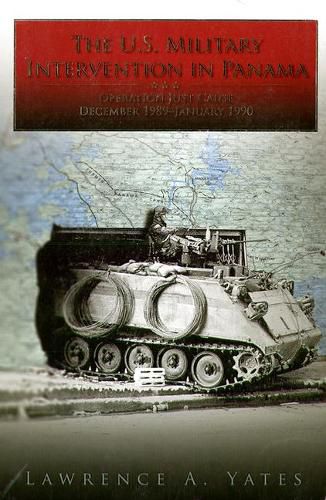Readings Newsletter
Become a Readings Member to make your shopping experience even easier.
Sign in or sign up for free!
You’re not far away from qualifying for FREE standard shipping within Australia
You’ve qualified for FREE standard shipping within Australia
The cart is loading…






NOTE: NO FURTHER DISCOUNT FOR THIS PRINT PRODUCT– OVERSTOCK SALE – Significantly reduced list price while supplies lastPrior to Operation JUST CAUSE, the December 1989 U.S. intervention in Panama, American leaders had struggled for over two years with the increasingly difficult regime of General Manuel Antonio Noriega. At the time, the Panama Canal was still under U.S. administration with the U.S. Southern Command, based at Quarry Heights, charged with its security. Led by General Frederick Woerner and seconded by Maj. Gen. Bernard Loeffke, the command’s Army component commander, American military leaders weathered a series of low-grade crises during 1988-1989, slowly culminating in a growing military confrontation with Noriega’s army, militia, and police forces. Detailed in Larry Yates’ study are the contingency plans, rules of engagement, and a host of varied operations-security patrols, guard duty, training exercises, shows of force, and police actions-and even the occasional firefight, all of which characterized this trying period.
But this history is much more than a precursor to JUST CAUSE. Its true value lies in its careful examination of the complex relationships between a U.S. combatant command, one of the four American global military headquarters, and the command’s Washington, D.C., superiors, including Joint Chiefs of Staff Chairman Admiral William Crowe, Army Chief of Staff General Carl Vuono, Defense Secretary Richard Cheney, and President George H. W. Bush. Indeed, the able Woerner and his staff often found themselves walking a tightrope between a variety of ill-defined administration policies whose long-range goals were difficult to fathom and the exigencies of a steadily worsening local situation. The result is a rich mix of timeless experiences and insights especially attuned to the contingency fare so common in the post-Cold War era.
Related products:
Panama Conflict resources collection can be found here: https: //bookstore.gpo.gov/catalog/us-military-history/battles-wars/panama-conflict
$9.00 standard shipping within Australia
FREE standard shipping within Australia for orders over $100.00
Express & International shipping calculated at checkout
NOTE: NO FURTHER DISCOUNT FOR THIS PRINT PRODUCT– OVERSTOCK SALE – Significantly reduced list price while supplies lastPrior to Operation JUST CAUSE, the December 1989 U.S. intervention in Panama, American leaders had struggled for over two years with the increasingly difficult regime of General Manuel Antonio Noriega. At the time, the Panama Canal was still under U.S. administration with the U.S. Southern Command, based at Quarry Heights, charged with its security. Led by General Frederick Woerner and seconded by Maj. Gen. Bernard Loeffke, the command’s Army component commander, American military leaders weathered a series of low-grade crises during 1988-1989, slowly culminating in a growing military confrontation with Noriega’s army, militia, and police forces. Detailed in Larry Yates’ study are the contingency plans, rules of engagement, and a host of varied operations-security patrols, guard duty, training exercises, shows of force, and police actions-and even the occasional firefight, all of which characterized this trying period.
But this history is much more than a precursor to JUST CAUSE. Its true value lies in its careful examination of the complex relationships between a U.S. combatant command, one of the four American global military headquarters, and the command’s Washington, D.C., superiors, including Joint Chiefs of Staff Chairman Admiral William Crowe, Army Chief of Staff General Carl Vuono, Defense Secretary Richard Cheney, and President George H. W. Bush. Indeed, the able Woerner and his staff often found themselves walking a tightrope between a variety of ill-defined administration policies whose long-range goals were difficult to fathom and the exigencies of a steadily worsening local situation. The result is a rich mix of timeless experiences and insights especially attuned to the contingency fare so common in the post-Cold War era.
Related products:
Panama Conflict resources collection can be found here: https: //bookstore.gpo.gov/catalog/us-military-history/battles-wars/panama-conflict